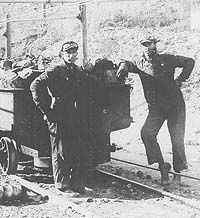| Two miners lean against a coal car at the Liberty Mine in Latuda, one of several mining communities that are now gone, sometime in the 1930’s. Coal has been king in Carbon county for a long time. |
Coal has long reigned as the king of industry in the Carbon County area, but gas and now even oil is starting to make a stab at that ranking.
In recently released information the coal production in the county for this year is projected to be higher than any year since yearly records were accumulated in 1960.
It is projected that this year the coal mines in the county will produce 12,845 thousand short tons. That will be up from 11,560 that were produced last year.
But while Carbon County is number one in coal in the state it has also solidified it’s standing as the number two producer of natural gas in Utah as well. In 2006, the county produced 82,337,741 cubic feet of natural gas, surpassed in the state by Uintah county which produced 203,522,421.
Carbon also now ranks eighth in oil production in the state. Last year the county produced 27,906 barrels of oil from its wells. Duchesne County was first with 6,401,299 barrels.
The growth pattern in non-coal energy is obviously tied to the countries need for both natural gas and oil. Increased prices have led to increased exploration and increased production.
When prices for either reach the levels where they are, and demand continues to grow, it means many exploration companies will go after supplies that only a few years ago were inaccessible because of cost. The Bill Barrett Corporation is a good example of that trend. The wells they are drilling on the Tavaputs Plateau are very deep, up to three times deeper than traditional wells in the area were. But the extreme cost to do that is offset by the higher prices.
In the oil business, with a barrel of oil approaching $100, companies are starting to make plans to drill deeper wells and to even look at wells that were capped many years ago because they were relatively tapped out. Now the increased cost of either re-drilling, injecting or just pumping out oil that remains that at one time couldn’t even pay for the cost of the pumping out the remaining barrels has become lucrative.
While Duchesne and Uintah counties have been on top for many years in terms of oil and gas production, a newcomer is on the scene which may displace them someday.
Sevier County’s growth in crude oil production shot up 132 percent in 2006 from 2005. Only four years ago the county produced no oil at all. Last year they produced 2,056,987 barrels of oil, making them fourth in the state. Sevier, however produces little or no natural gas.
From 1870-1959 it is estimated that Carbon county produced a total of 211,028 thousand short tons of coal. In the last 47 years the county has produced another 243,514 thousand short tons, due to advanced and automated mining techniques.
But the growth of output has not always been steady largely due to weak market conditions at certain times. While the coal industry put out 3,698 thousand short tons in 1960 and continue at about that rate up through the late 1970’s and 1980’s the poorest year in the last 50 was 1993 when the price was very depressed and the industry only produced 2,642 thousand short tons. Since then, with the exception of 1995 when production fell from the year before, and 1999, the rate of production increase has been on a steady incline.

